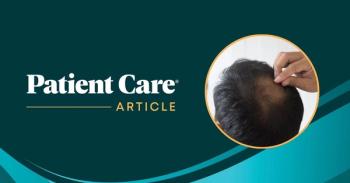
Acne Conglobata
For 3 months, a 24-year-old man-a military aviator-had a worsening rash on his chest. He had no lesions elsewhere. Culture of the ulcers grew Pseudomonas. A 2-week course of antibiotic therapy was ineffective.
For 3 months, a 24-year-old man-a military aviator-had a worsening rash on his chest. He had no lesions elsewhere. Culture of the ulcers grew Pseudomonas. A 2-week course of antibiotic therapy was ineffective.
Acne conglobata was diagnosed. This disorder occurs most often in men between the ages of 18 and 30. The exact cause is unknown; however, changes in the body’s reactivity to Propionibacterium acnes, exposure to halogenated aromatic hydrocarbons, ingestion of halogens, and exposure to excessive androgens may provoke acne conglobata in genetically susceptible persons. Acne conglobata is associated with PAPA syndrome (a rare autosomal dominant disorder characterized by pyogenic arthritis, pyoderma gangrenosum, and acne), hidradenitis suppurativa, and renal amyloidosis.
The hallmarks of acne conglobata are deep abscesses, inflammation, scarring, and destruction of normal skin. Flares generally start with groups of comedones, which transform into inflammatory nodules that leak a purulent, sometimes foul-smelling exudate. Ulcers may form below the nodules. Deeply ulcerated nodules usually develop crusts. The development of interconnecting sinuses and abscesses results in keloidal and atrophic scars, as seen in this patient.
The mainstay of treatment is a 5-month course of isotretinoin, which should be started early to reduce and prevent scarring. A 2- to 4-week course of a systemic corticosteroid, such as prednisone, is also effective. If isotretinoin cannot be used, a systemic antibiotic (ie, tetracycline or erythromycin) or hormonal therapy (for women) is recommended. Topical treatment is relatively ineffective, although intralesional injections of triamcinolone may be helpful. For patients with large or interconnecting nodules, consider aspiration or surgical excision. The healing process is extremely slow and leaves pronounced disfiguring scars. Because of this, patients may also require psychological support.
Because of the restrictions placed on military aviators, this patient could not take isotretinoin. However, he was able to take oral doxycycline, 100 mg twice a day, which stabilized the disease process. He plans to pursue cosmesis for the scarring at a later time.
The opinions contained herein are those of the authors and should not be construed as official or as reflecting the views of the US Air Force or the Department of Defense.
Newsletter
Enhance your clinical practice with the Patient Care newsletter, offering the latest evidence-based guidelines, diagnostic insights, and treatment strategies for primary care physicians.
















































































































































































































































































